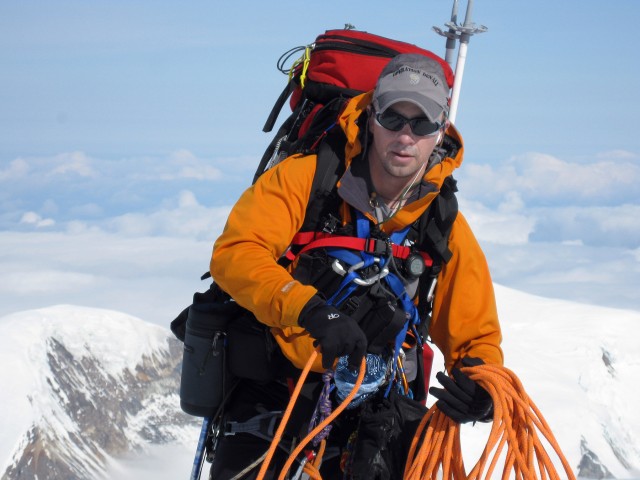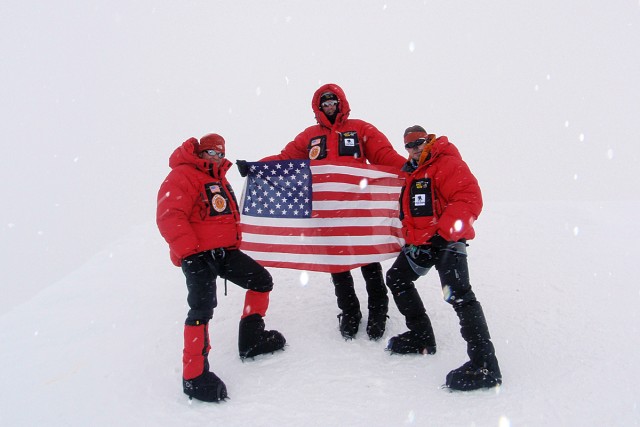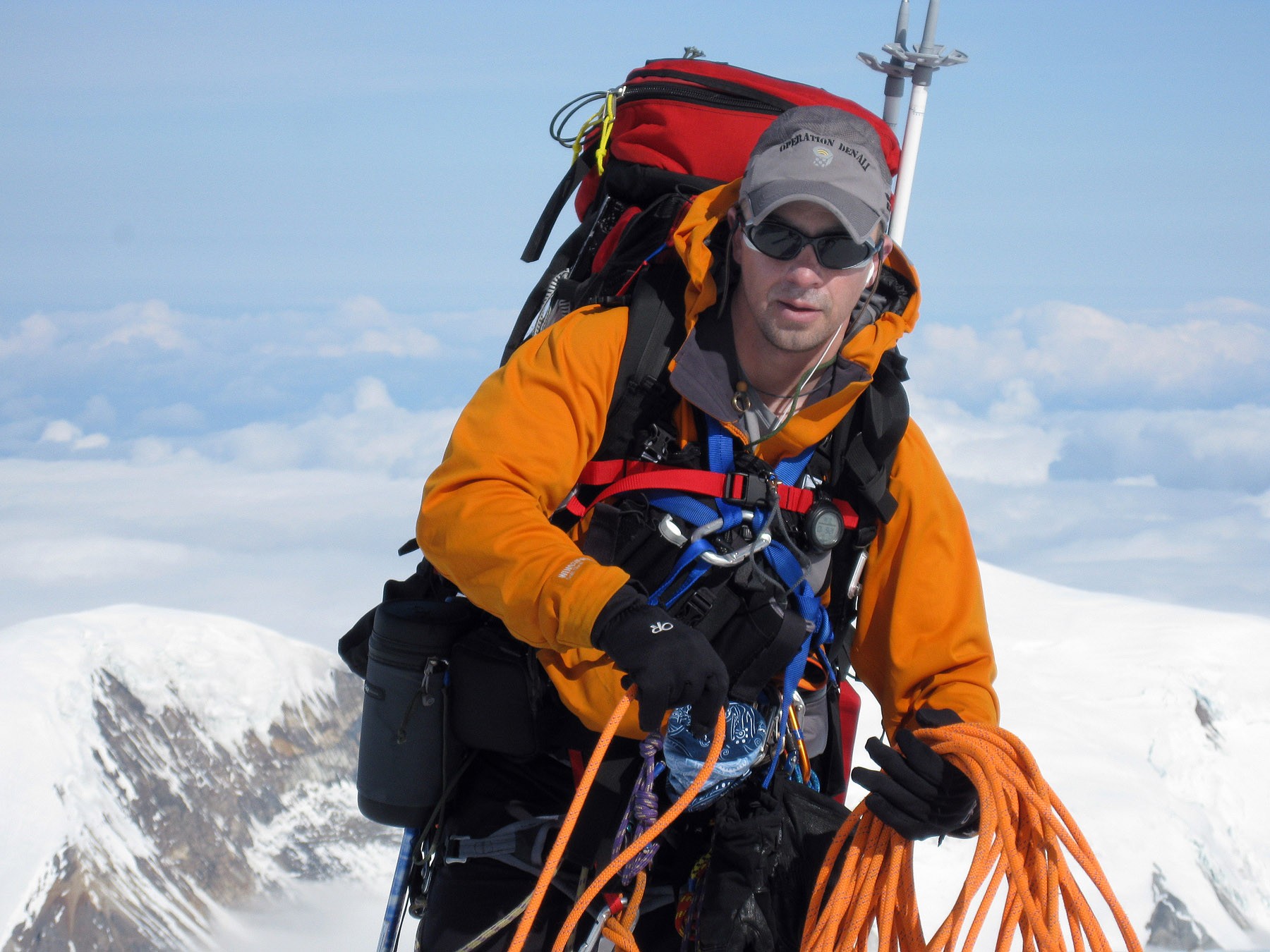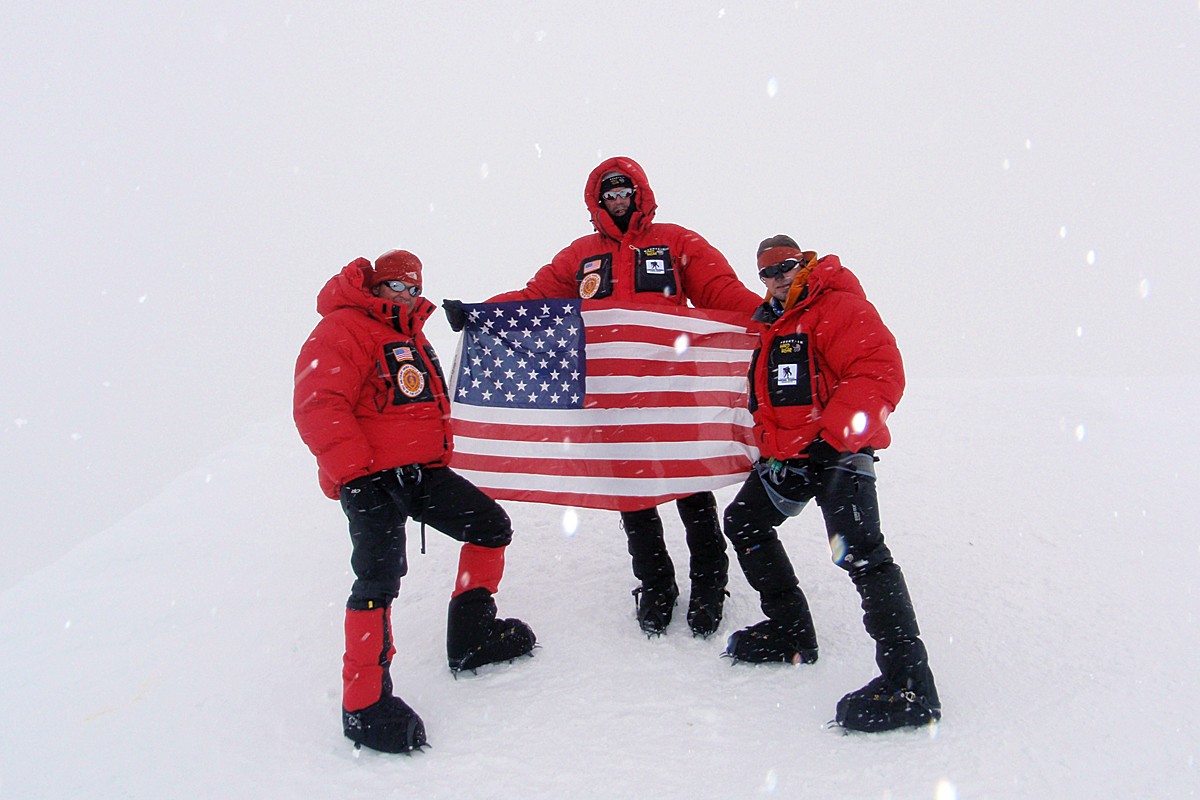FORT RICHARDSON, Alaska (March 4, 2010) -- Wounded by a roadside bomb more than three years ago, Lt. Col. Marc Hoffmeister has surmounted his injuries to tie for the National Geographic magazine's Reader's Choice Adventurer of the Year Award.
Hoffmeister organized a mountaineering team for a Mount McKinley expedition last year that included four wounded veterans.
When not on duty as the chief engineer for the Alaskan Command/Joint Task Force Alaska, he found sponsors for "Operation Denali" and began training a team for the expedition. Along with Hoffmeister, his wife Gayle and longtime friend Bob Haines were:
Aca,!Ac Spc. David Shebib, another wounded warrior from the 4th Brigade Combat Team, 25th Infantry Division, who suffered severe head and chest injuries.
Aca,!Ac Marine Capt. Jon Kuniholm, who lost his right arm while serving in Iraq.
Aca,!Ac Retired Army Sgt. 1st Class Matthew Nyman, who lost his right leg below the knee while serving in Iraq.
Teamwork was key
The climbers had to learn how to use teamwork to mitigate individual disabilities, Hoffmeister said.
"Who can tie knots for me and for Jon because our hands don't work'" Hoffmeister asked. "How do we handle load distribution or how do we handle snowshoes for Matt who's working off of a prosthetic leg' How do we protect Dave's face from the UV radiation from the snow'"
"It was necessary for all of us to be in tune with where we were at physically and mentally throughout the climb and then adjust the team's pace or load or take a rest day based upon how somebody else was doing in the team," he continued.
With Kuniholm succumbing to high altitude pulmonary edema at 16,200 feet, Nyman suffering from mountain sickness at 17,200 feet and Gayle Hoffmeister showing signs of mild hypothermia at 18,000 feet, Marc Hoffmeister said only he, Shebib, Haines and guide Kirby Senden were able to make the summit.
"Your average success rate on Denali for an able-bodied team is 50 percent regardless," Hoffmeister detailed. "We were at the 50 percent number, not because of our injuries but because of the beast of altitude."
With a successful ascent for the team June 16, Hoffmeister said he feels the implications of the achievement reach beyond the members of the team.
"Our whole experience as a team is a sort of microcosm of what you see in the Army with all of our wounded warriors and it takes a team to recover," he said. "It takes a team to have that bond of support, that family to carry you through the hard times and to encourage you, motivate you and get you to the top, whether that's a mountain, the top of the stairs or the first time running on new legs."
Long journey back
Hoffmeister was injured during his second deployment to Iraq with 4th Brigade Combat Team, 25th Infantry Division, based out of Fort Richardson, Alaska. He was dual-hatted, serving as Task Force Warrior operations officer and deputy team leader of Military Transition Team 820 partnering with the Iraqi Army's 2nd Battalion, 2nd Brigade.
Seven months into his deployment, his Humvee was hit by an improvised explosive device during a routine convoy mission.
"Everyone in the truck was wounded, but we all survived," he said in a stark voice. "Pretty significant life-altering day. It was definitely intense because one minute you're feeling on top of your game and somewhat in control of your destiny and the next day you realize very quickly that you're not."
Hoffmeister said he lost consciousness for a brief period of time before hearing the MiTT interpreter through his shattered door.
"I came to as the vehicle was careening off the road and looking through a hole in my arm at my radio, trying to report," Hoffmeister recalled. "My translator was running next me, next to the truck - he was behind me, the door had been blown open - and he had dismounted or was thrown out and he's running next to the truck. The first thing I heard was Sean yelling into my ear...'Sir, sir you must dismount the vehicle.' It was very surreal."
Hoffmeister rendered self aid before a medevac helicopter took him to a Combat Support Hospital in Baghdad where he was stabilized and flown to Balad Air Base bound for Landstuhl Regional Medical Center, Germany. After multiple surgeries, he was then flown to Madigan Army Medical Center, Fort Lewis, where he was reunited with wife, Gayle Hoffmeister.
Returning home to Fort Richardson, Hoffmeister said he began a long recovery process, relying on some tough love from his wife Gayle to scale back on pain medication and to venture outside of the couple's home to enjoy their shared passion of the outdoors.
"She's the kind of person who, if she doesn't get out and get any PT, or get some physical activity or just breathe fresh air, she gets a little spun up," he elaborated. "So me hanging out on the couch trying to deal with my wounds is only going to last so long with her. She was a pretty good judge, a better judge of where I was at than I was."
Despite carrying an antibiotic drip to fight an aggressive enterobacter infection associated with desert blast injuries, Hoffmeister said he attended spin class and hiked Crow Pass with his determined spouse.
Hence, climbing Denali came about as a progression of the couple's efforts to speed his recovery.
"The concept of Denali started when Gayle told me she was climbing Denali and that was a very perfunctory statement," he related. "There was no questions, ands, ifs or buts. There wasn't even an invitation. She just told me she was climbing it. I said, 'OK, not without me.'"
"That was my first thought followed by fear of 'Oh crap, my arm's going to freeze because I can't feel it' or 'Am I really going to be able to do this''" Hoffmeister continued. "From that thought process, I was like 'You know, if I'm feeling that way, there's probably other folks that feel the same way. Let's find them.'"
Honor goes beyond team
Hoffmeister's climb up the dangerous West Buttress route of Mount McKinley June 16, tied for National Geographic Reader's Choice Award with engineer Albert Yu-Min Lin who organized an expedition into northern Mongolia's "Forbidden Zone" to search for the lost tomb of Genghis Khan using new mapping technologies.
Being named Adventurer of the Year was an honor which has implications for other wounded warriors, Hoffmeister said.
"The climb wasn't about us," he explained. "One of our goals was to demonstrate by example that we could overcome any obstacles through perseverance and the human spirit.
"We also wanted to spread the word, to share our stories and inspire other guys who are where we were a year, two years ago wondering 'I don't have an arm, what am I going to do with my life' It's over.' Well, no, the story is not over."
Slated to take command of 6th Engineer Battalion, 3rd Maneuver Enhancement Brigade, this summer, Hoffmeister recently returned from what he termed a relaxing vacation climbing Mount Kilimanjaro, Tanzania, with his wife.
Not content to rest on his crampons, the Army engineer said he would like to lead another wounded warrior climb up Argentina's 22,000-foot Cerro Aconcaqua, the highest peak in the Americas.
"There's a lot on my bucket list," he said with a laugh. "I'm an engineer. It's a big bucket."
(David Bedard serves with the Fort Richardson Public Affairs Office.)




Social Sharing